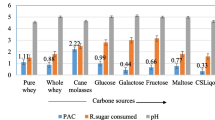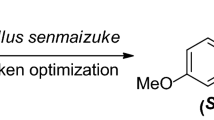Abstract
(S)-Omeprazole is a very effective anti-ulcer medicine that is difficult to be prepared using whole cells at elevated substrate concentrations. In the chloroform–water biphasic system, resting cells of the mutant QZ-3 of Rhodococcus rhodochrous (R. rhodochrous) ATCC 4276 were used to catalyze the bio-oxidation of omeprazole sulfide for preparation of (S)-omeprazole. Using response surface methodology (RSM), the reaction was optimized to work at a substrate concentration of 180 mM and a cell concentration of 100 g/L. The optimal yield of (S)-omeprazole obtained was 92.9% with enantiomeric excess (ee) (> 99%), and no sulfone by-product was detected under the optimal working conditions; reaction temperature 37 °C, pH 7.3 and reaction time, 43 h. A quadratic polynomial model was established, which predicts the experimental data with very high accuracy (R2 = 0.9990). The chloroform–water biphasic system may contribute to the significant improvement in substrate tolerance because almost all substrates are partitioned in the organic phase (water solubility of omeprazole sulfide is only about 0.5 mg/mL), resulting in little damage and inhibition to cells by substrates. The mutant QZ-3 of R. rhodochrous ATCC 4276 exhibited high enantioselectivity, activity and substrate and product tolerance. The aerated flask provides enough oxygen for a high concentration of cells. Accordingly, bio-oxidation is thus more promising for efficient preparation of chiral sulfoxides.




Similar content being viewed by others
References
Pai V, Pai N (2007) Recent advances in chirally pure proton pump inhibitors. J Indian Med Assoc 105:469–470, 472, 474
Andersson T, Weidolf L (2008) Stereoselective disposition of proton pump inhibitors. Clin Drug Investig 28:263–279. https://doi.org/10.2165/00044011-200828050-00001
Maitro G, Prestat G, Madec D, Poli G (2010) An escapade in the world of sulfenate anions: generation, reactivity and applications in domino processes. Tetrahedron Asymmetr 21:1075–1084. https://doi.org/10.1016/j.tetasy.2010.05.035
Delamare M, Belot S, Caille JC et al (2009) A new titanate/(+)-(1R,2S)-cis-1-amino-2-indanol system for the asymmetric synthesis of (S)-tenatoprazole. Tetrahedron Lett 50:1702–1704. https://doi.org/10.1016/j.tetlet.2009.01.111
Adam W, Korb MN, Roschmann KJ, Saha-Moller CR (1998) Titanium-catalyzed, asymmetric sulfoxidation of alkyl aryl sulfides with optically active hydroperoxides. J Org Chem 63:3423–3428. https://doi.org/10.1021/jo980243y
Dembitsky VM (2003) Oxidation, epoxidation and sulfoxidation reactions catalysed by haloperoxidases. Tetrahedron 26:4701–4720. https://doi.org/10.1016/s0040-4020(03)00701-4
Kamerbeek NM, Olsthoorn AJ, Fraaije MW, Janssen DB (2003) Substrate specificity and enantioselectivity of 4-hydroxyacetophenone monooxygenase. Appl Environ Microbiol 69:419–426. https://doi.org/10.1128/aem.69.1.419-426.2003
Zambianchi F, Fraaije MW, Carrea G et al (2007) Titration and assignment of residues that regulate the enantioselectivity of phenylacetone monooxygenase. Adv Synth Catal 349:1327–1331. https://doi.org/10.1002/adsc.200600598
Van Deurzen MPJ, van Rantwijk F, Sheldon RA (1997) Selective oxidations catalyzed by peroxidases. Tetrahedron 53:13183–13220. https://doi.org/10.1016/S0040-4020(97)00477-8
Colonna S, Gaggero N, Richelmi C, Pasta P (1999) Recent biotechnological developments in the use of peroxidases. Trends Biotechnol 17:163–168. https://doi.org/10.1016/S0167-7799(98)01288-8
Adam W, Heckel F, Saha-Möller CR, Schreier P (2002) Biocatalytic synthesis of optically active oxyfunctionalized building blocks with enzymes, chemoenzymes and microorganisms. J Organomet Chem 661:17–29. https://doi.org/10.1016/s0022-328x(02)01805-3
Dzyuba SV, Klibanov AM (2003) Asymmetric thiosulfinations catalyzed by bovine serum albumin and horseradish peroxidase. Biotechnol Lett 25:1961–1965. https://doi.org/10.1023/b:bile.0000004385.50406.06
Ozaki S, Yang HJ, Matsui T et al (1999) Asymmetric oxidation catalyzed by myoglobin mutants. Tetrahedron Asymmetr 10:183–192. https://doi.org/10.1016/S0957-4166(98)00498-4
Ozaki S, Matsui T, Watanabe Y (1997) Conversion of myoglobin into a peroxygenase: a catalytic intermediate of sulfoxidation and epoxidation by the F43H/H64L mutant. J Am Chem Soc 119:6666–6667. https://doi.org/10.1021/ja970453c
Akasaka R, Mashino T, Hirobe M (1993) Cytochrome P450-like substrate oxidation catalyzed by cytochrome c and immobilized cytochrome c. Arch Biochem Biophys 301:355–360. https://doi.org/10.1006/abbi.1993.1155
Maczka W, Wińska K, Grabarczyk M (2018) Biotechnological methods of sulfoxidation: yesterday today, tomorrow. Catalysts 8:624–650. https://doi.org/10.3390/catal8120624
Gao F, Wang L, Liu Y et al (2015) Enzymatic synthesis of (R)-modafinil by chloroperoxidase-catalyzed enantioselective sulfoxidation of 2-(diphenylmethylthio) acetamide. Biochem Eng J 93:243–249. https://doi.org/10.1016/j.bej.2014.10.017
Pereira PC, Arends IWCE, Sheldon RA (2015) Optimizing the chloroperoxidase-glucose oxidase system: the effect of glucose oxidase on activity and enantioselectivity. Process Biochem 50:746–751. https://doi.org/10.1016/j.procbio.2015.02.006
Bisagni S, Summers B, Kara S et al (2014) Exploring the substrate specificity and enantioselectivity of a Baeyer–Villiger monooxygenase from Dietzia sp. D5: oxidation of sulfides and aldehydes. Top Catal 57:366–375. https://doi.org/10.1007/s11244-013-0192-1
Reetz MT, Daligault F, Brunner B et al (2004) Directed evolution of cyclohexanone monooxygenases: enantioselective biocatalysts for the oxidation of prochiral thioethers. Angew Chem 116:4170–4173. https://doi.org/10.1002/ange.200460311
Carballeira JD, Quezada MA, Hoyos P et al (2009) Microbial cells as catalysts for stereoselective red-ox reactions. Biotechnol Adv 27:686–714. https://doi.org/10.1016/j.biotechadv.2009.05.001
Olivo HF, Osorio-Lozada A, Peeples TL (2005) Microbial oxidation/amidation of benzhydrylsulfanyl acetic acid. Synthesis of (+)-modafinil. Tetrahedron Asymmetr 16:3507–3511. https://doi.org/10.1016/j.tetasy.2005.07.028
Pinedo-Rivilla C, Aleu J, Collado IG (2007) Enantiomeric oxidation of organic sulfides by the filamentous fungi Botrytis cinerea, Eutypa lataand Trichoderma viride. J Mol Catal B Enzym 49:18–23. https://doi.org/10.1016/j.molcatb.2007.07.001
Ricci LC, Comasseto JV, Andrade LH et al (2005) Biotransformations of aryl alkyl sulfides by whole cells of white-rot Basidiomycetes. Enzyme Microb Technol 36:937–946. https://doi.org/10.1016/j.enzmictec.2005.01.021
Borges KB, Borges WD, Duran-Patron R et al (2009) Stereoselective biotransformations using fungi as biocatalysts. Tetrahedron Asymmetr 20:385–397. https://doi.org/10.1016/j.tetasy.2009.02.009
Li AT, Yu HL, Pan JA et al (2011) Resolution of racemic sulfoxides with high productivity and enantioselectivity by a Rhodococcus sp. strain as an alternative to biooxidation of prochiral sulfides for efficient production of enantiopure sulfoxides. Bioresour Technol 102:1537–1542. https://doi.org/10.1016/j.biortech.2010.08.025
Elkin AA, Kylosova TI, Grishko VV, Ivshina IB (2013) Enantioselective oxidation of sulfides to sulfoxides by Gordonia terrae IEGM 136 and Rhodococcus rhodochrous IEGM 66. J Mol Catal B Enzym 89:82–85. https://doi.org/10.1016/j.molcatb.2012.12.001
Holland HL, Brown FM, Lakshmaiah G et al (1997) Biotransformation of organic sulfides—VII. A predictive model for sulfoxidation by Helminthosporium species NRRL 4671. Tetrahedron Asymmetr 8:683–697. https://doi.org/10.1016/S0957-4166(97)00006-2
Li AT, Zhang JD, Xu JH et al (2009) Isolation of Rhodococcus sp. strain ECU0066, a new sulfide monooxygenase-producing strain for asymmetric sulfoxidation. Appl Environ Microbiol 75:551–556. https://doi.org/10.1128/AEM.01527-08
Holland HL, Brown FM, Kerridge A et al (2003) Biotransformation of sulfides by Rhodocoeccus erythropolis. J Mol Catal B Enzym 22:219–223. https://doi.org/10.1016/s1381-1177(03)00040-7
Li AT, Zhang JD, Yu HL et al (2011) Significantly improved asymmetric oxidation of sulfide with resting cells of Rhodococcus sp. in a biphasic system. Process Biochem 46:689–694. https://doi.org/10.1016/j.procbio.2010.11.010
Han J, Soloshonok VA, Klika KD, Drabowicz J, Wzorek A (2018) Chiral sulfoxides: advances in asymmetric synthesis and problems with the accurate determination of the stereochemical outcome. Chem Soc Rev 47:1307–1350. https://doi.org/10.1039/C6CS00703A
Mascotti ML, Orden AA, Bisogno FR et al (2012) Aspergillus genus as a source of new catalysts for sulfide oxidation. J Mol Catal B Enzym 82:32–36. https://doi.org/10.1016/j.molcatb.2012.05.003
Mascotti ML, Palazzolo MA, Lewkowicz E, Kurina-Sanz M (2013) Expanding the toolbox for enantioselective sulfide oxidations: Streptomyces strains as biocatalysts. Biocatal Agric Biotechnol 2:399–402. https://doi.org/10.1016/j.bcab.2013.08.003
Chen Y, Zhuo J, Zheng D et al (2014) Stereoselective oxidation of sulfides to optically active sulfoxides with resting cells of Pseudomonas monteilii CCTCC M2013683. J Mol Catal B Enzym 106:100–104. https://doi.org/10.1016/j.molcatb.2014.05.004
Holt R, Lindberg P, Reeve C, Taylor S (1998) Preparation of pharmaceutically active compounds by biooxidation. U.S. Patent No. 5,840,552
Yoshida T, Kito M, Tsujii M, Nagasawa T (2001) Microbial synthesis of a proton pump inhibitor by enantioselective oxidation of a sulfide into its corresponding sulfoxide by Cunninghamella echinulata MK40. Biotechnol Lett 23:1217–1222. https://doi.org/10.1023/a:1010521217954
Gong PF, Xu JH (2005) Bio-resolution of a chiral epoxide using whole cells of Bacillus megaterium ECU1001 in a biphasic system. Enzyme Microb Technol 36:252–257. https://doi.org/10.1016/j.enzmictec.2004.07.014
He JY, Sun ZH, Ruan WQ, Xu Y (2006) Biocatalytic synthesis of ethyl (S)-4-chloro-3-hydroxy-butanoate in an aqueous–organic solvent biphasic system using Aureobasidium pullulans CGMCC 1244. Process Biochem 41:244–249. https://doi.org/10.1016/j.procbio.2005.06.028
Kansal H, Banerjee UC (2009) Enhancing the biocatalytic potential of carbonyl reductase of Candida viswanathii using aqueous–organic solvent system. Bioresour Technol 100:1041–1047. https://doi.org/10.1016/j.biortech.2008.08.042
El’kin AA, Grishko VV, Ivshina IB (2010) Oxidative biotransformation of thioanisole by Rhodococcus rhodochrous IEGM 66 cells. Appl Biochem Microbiol 46:586–591. https://doi.org/10.1134/S0003683810060050
Holland HL, Poddar S, Tripet B (1992) Effect of cell immobilization and organic solvents on sulfoxidation and steroid hydroxylation by Mortierella isabellina. J Ind Microbiol 10:195–197. https://doi.org/10.1007/BF01569766
Holland HL, Rand CG, Viski P, Brown FM (1991) Microbial oxidation of benzyl sulfides and bibenzyl by Mortierella isabellina and Helminthosporium species. Can J Chem 69:1989–1993. https://doi.org/10.1139/v91-287
Tarasova EV, Grishko VV, Ivshina IB (2017) Cell adaptations of Rhodococcus rhodochrous IEGM 66 to betulin biotransformation. Process Biochem 52:1–9. https://doi.org/10.1016/j.procbio.2016.10.003
Aguirre-Pranzoni C, Bisogno FR, Orden AA, Kurina-Sanz M (2015) Lyophilized rhodotorula yeast as all-in-one redox biocatalyst: access to enantiopure building blocks by simple chemoenzymatic one-pot procedures. J Mol Catal B Enzym 114:19–24. https://doi.org/10.1016/j.molcatb.2014.07.011
Grishko VV, Tarasova EV, Ivshina IB (2013) Biotransformation of betulin to betulone by growing and resting cells of the actinobacterium Rhodococcus rhodochrous IEGM 66. Process Biochem 48:1640–1644. https://doi.org/10.1016/j.procbio.2013.08.012
Holland HL, Brown FM, Larsen BG, Zabic M (1995) Biotransformation of organic sulfides. Part 7. Formation of chiral isothiocyanato sulfoxides and related compounds by microbial biotransformation. Tetrahedron Asymmetr 6:1569–1574. https://doi.org/10.1016/0957-4166(95)00200-9
Salama S, Dishisha T, Habib MH et al (2020) Enantioselective sulfoxidation using Streptomyces glaucescens GLA.0. RSC Adv 10:32335–32344
He YC, Ma CL, Yang ZX et al (2013) Highly enantioselective oxidation of phenyl methyl sulfide and its derivatives into optically pure (S)-sulfoxides with Rhodococcus sp. CCZU10-1 in an n-octane-water biphasic system. Appl Microbiol Biotechnol 97:10329–10337. https://doi.org/10.1007/s00253-013-5258-2
He YC, Zhou Q, Ma CL et al (2012) Biosynthesis of benzoylformic acid from benzoyl cyanide by a newly isolated Rhodococcus sp. CCZU10-1 in toluene–water biphasic system. Bioresour Technol 115:88–95. https://doi.org/10.1016/j.biortech.2011.09.084
Seenivasaperumal M, Federsel HJ, Szab K (2010) Mechanism of the asymmetric sulfoxidation in the esomeprazole process: effects of the imidazole backbone for the enantioselection. Adv Synth Catal 351:903–919. https://doi.org/10.1002/adsc.200800753
Waghmare GV, Chatterji A, Rathod VK (2017) Kinetics of enzymatic synthesis of cinnamyl butyrate by immobilized lipase. Appl Biochem Biotechnol 183:792–806. https://doi.org/10.1007/s12010-017-2464-x
Kim Y, Nicell JA (2006) Laccase-catalysed oxidation of aqueous triclosan. J Chem Technol Biotechnol 81:1344–1352. https://doi.org/10.1002/jctb.1507
de Miranda AS, Miranda LS, de Souza RO (2015) Lipases: valuable catalysts for dynamic kinetic resolutions. Biotechnol Adv 33:372–393. https://doi.org/10.1016/j.biotechadv.2015.02.015
Mathpati AC, Badgujar KC, Bhanage BM (2016) Kinetic modeling and docking study of immobilized lipase catalyzed synthesis of furfuryl acetate. Enzyme Microb Technol 84:1–10. https://doi.org/10.1016/j.enzmictec.2015.12.003
Luo DH, Zong MH, Xu JH (2003) Biocatalytic synthesis of (−)-1-trimethylsilylethanol by asymmetric reduction of acetyltrimethylsilane with a new isolate Rhodotorula sp. AS2. 2241. J Mol Catal B Enzym 24:83–88. https://doi.org/10.1016/S1381-1177(03)00114-0
Nourani M, Baghdadi M, Javan M, Bidhendi GN (2016) Production of a biodegradable flocculant from cotton and evaluation of its performance in coagulation-flocculation of kaolin clay suspension: optimization through response surface methodology (RSM). J Environ Chem Eng 4:1996–2003. https://doi.org/10.1016/j.jece.2016.03.028
Babiak P, Kyslíková E, Šteˇpánek V et al (2011) Whole-cell oxidation of omeprazole sulfide to enantiopure esomeprazole with Lysinibacillus sp. B71. Bioresour Technol 102:7621–7626. https://doi.org/10.1016/j.biortech.2011.05.052
Acknowledgements
The authors gratefully acknowledge financial support from China Scholarship Council (Grant Number: 201908370079) and Shandong Provincial Key R&D Program [Grant Numbers 2019GSF107027, 2019GNC106028 and 2019GSF107033].
Author information
Authors and Affiliations
Corresponding authors
Ethics declarations
Conflict of interest
The authors declare that they have no conflict of interest.
Additional information
Publisher's Note
Springer Nature remains neutral with regard to jurisdictional claims in published maps and institutional affiliations.
Rights and permissions
About this article
Cite this article
Zhang, Y., Lv, K., Deng, Y. et al. Asymmetric Bio-oxidation Using Resting Cells of Rhodococcus rhodochrous ATCC 4276 Mutant QZ-3 for Preparation of (S)-Omeprazole in a Chloroform–Water Biphasic System Using Response Surface Methodology. Catal Lett 151, 2928–2938 (2021). https://doi.org/10.1007/s10562-021-03531-w
Received:
Accepted:
Published:
Issue Date:
DOI: https://doi.org/10.1007/s10562-021-03531-w




